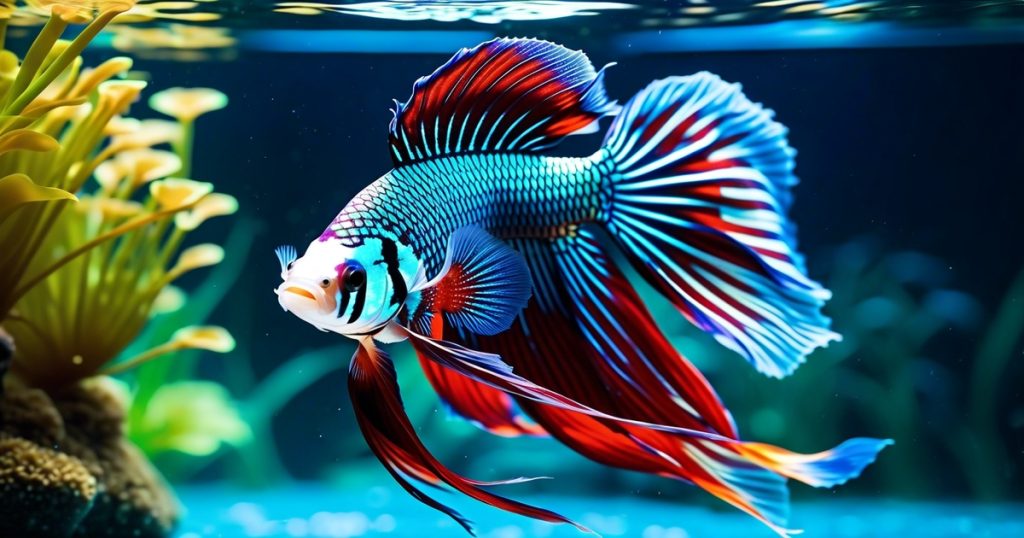Ever wondered why your betta fish is lying on its side at the bottom of the tank? It can be quite alarming to see your vibrant healthy betta in such a state. In this post, we’ll delve into the possible reasons behind this behavior and what you can do to help your healthy betta in a different tank. From water quality issues to swim bladder problems, we’ll explore the contrasting scenarios that may lead to this peculiar position of your betta fish.
Table of Contents
ToggleRecognizing Normal vs. Concerning Betta Fish Positions

Signs of Normal Resting
Betta fish commonly rest on leaves or at the bottom of the tank, displaying a relaxed and peaceful demeanor. They may even take short naps lying on their side, which is typically considered normal behavior. It’s essential for hobbyists to observe their fish, betta, during these resting periods to understand what is typical for them.
Bettas, fish, are known to be active swimmers, but they also require adequate rest. When they’re not exploring their environment or interacting with other tankmates, fish find a comfortable spot in the tank where they can relax and unwind.
Identifying Concerning Behavior
If you notice your betta fish spending excessive time at the bottom of the tank and lying on its side frequently, this could be an indication of an underlying issue. If your betta fish appears to be struggling with buoyancy and keeps floating or sinking uncontrollably, it’s crucial to consider potential health problems.
Observing changes in behavior such as reduced appetite, lethargy, or unusual swimming patterns in your fish can provide valuable insights into its well-being. These signs might indicate issues related to swim bladder disease or other health concerns that require prompt attention from a knowledgeable aquarium hobbyist or veterinarian.
Exploring Swim Bladder Disorder in Betta Fish
Factors Contributing to Swim Bladder Disorder
Swim bladder disorder can lead to betta fish lying on their sides at the bottom of the tank. Overfeeding is a common cause, as it can lead to constipation, putting pressure on the fish’s swim bladder. Poor water quality also plays a role in causing fish swim bladder issues. When bettas are exposed to unclean water conditions, fish can result in stress and susceptibility to various health problems, including swim bladder disorder.
The irregular positioning of your betta fish may indicate that they are struggling with buoyancy due to swim bladder complications. If you notice your betta fish exhibiting unusual swimming behaviors or resting at odd angles at the bottom of the tank, it’s crucial to consider potential swim bladder problems as one of the causes.
Seeking Professional Assistance
If you observe your betta fish displaying signs associated with swim bladder disorder, such as laying on its side at the bottom of the tank, consulting a vet who specializes in aquatic animals is essential. A professional veterinarian will be able to provide an accurate diagnosis and recommend appropriate treatment for your beloved pet.
- Overfeeding and poor water quality contribute to fish swim bladder issues.
- Unusual swimming behaviors or resting positions might signal a problem.
- Consulting a vet specializing in aquatic animals is crucial if you suspect swim bladder disorder in fish.
Addressing Water Quality Issues in Betta Tanks
Importance of Water Quality
Maintaining good water quality is crucial for the health and well-being of betta fish. Poor water conditions can lead to stress, illness, and even prove fatal for these beautiful fish. When the aquarium water becomes polluted with waste and uneaten food, it can create an environment that is harmful to your betta fish.
Regularly changing a portion of the water volume in the tank helps remove accumulated waste and toxins that could cause harm to your fish. Without proper maintenance, fish ammonia levels can rise, leading to ammonia poisoning, which may manifest as symptoms such as lethargy or abnormal swimming behavior.
The Role of Filtration
A good filtration system plays a vital role in maintaining a healthy aquatic environment for bettas and fish. It helps in removing debris from the water column, ensuring that it remains clean and clear. By providing adequate water flow and facilitating beneficial bacterial growth, filters contribute significantly to keeping ammonia levels low for fish.
Testing the water parameters regularly using a reliable test kit is essential for monitoring key indicators like pH level, ammonia, nitrite, and nitrate concentrations. This practice enables you to detect any potential issues early on before they escalate into serious problems for your betta fish.
Understanding the Impact of Tank Conditions on Betta Health
Tank Conditions and Betta Well-being
Different tank sizes, temperatures, and decorations play a crucial role in tank maintenance, directly affecting a betta fish’s health. For instance, a small tank can lead to stress for the betta fish due to limited space for swimming. Similarly, extreme temperatures or lack of proper hiding spots can also cause fish stress.
Inadequate tank conditions don’t just affect the physical well-being of bettas; they can also weaken their immune system, making them more susceptible to illnesses. This means that maintaining proper tank conditions is essential not only for preventing immediate health issues but also for supporting your betta fish’s long-term well-being.
Properly maintained tanks with suitable sizes, stable temperatures, enriching decorations, and fish provide an environment where bettas feel secure and comfortable. This reduces their stress levels and strengthens their immune systems, ultimately helping them stay healthy and vibrant.
Preventing Health Issues in Betta Fish
To prevent your betta fish from laying on its side at the bottom of the tank due to poor conditions or other health issues
- Ensure you have a fish tank size that meets the minimum requirement (at least 5 gallons).
- Use a heater to maintain water temperature between 78-80°F for fish.
- Add live or silk plants as well as caves or ornaments for shelter.
- Perform regular water changes to keep ammonia levels low.
Identifying Common Betta Fish Ailments and Treatments
Common Ailments
Betta fish are susceptible to various health issues such as fin rot, ich, and velvet disease. Fin rot is characterized by the deterioration of the fins, while ich manifests as tiny white spots on the fish’s body. Velvet disease presents itself with a gold or rust-colored dusting over the betta’s scales.
These ailments can lead to your betta fish exhibiting abnormal behavior like laying on its side at the bottom of the tank. This behavior could be an indication of distress caused by these health problems.
Treatments and Monitoring
When you notice your betta fish displaying unusual behavior such as lying sideways at the bottom of its tank, it’s crucial to take immediate action. Start by examining water parameters including temperature and pH levels for fish. Consider treating your betta fish with appropriate medication based on their symptoms. For instance, if you observe white spots indicative of ich on your fish, using medication specifically designed for this ailment can help alleviate their suffering.
Regularly monitor your betta fish for any signs of illness or distress; early detection allows for prompt treatment which increases their chances of recovery.
Managing Betta Fish Stress and Compatibility with Tank Mates
Introducing Tank Mates
It’s crucial to do so carefully. Some fish species can cause stress for bettas, leading them to exhibit unusual behaviors like laying on their side at the bottom of the tank. To minimize stress, choose peaceful fish and non-fin-nipping tank mates that won’t disrupt your betta’s environment.
For instance, small fish, snails, or peaceful shrimp can make suitable companions for bettas. These creatures are less likely to bother or stress out your betta fish. By selecting compatible fish tank mates, you create a harmonious environment that reduces the likelihood of your betta displaying distressing behavior.
Providing Hiding Spots
Creating an environment with hiding spots is essential in reducing stress levels for your betta fish. When fish feel overwhelmed or threatened, they seek refuge in hiding places within their tanks. Adding plants and decorations where fish can retreat when needed helps alleviate stress and makes them feel safe and secure in their habitat.
Ensuring there is enough space within the tank allows each fish to establish its territory without feeling overcrowded or threatened by other inhabitants. This setup minimizes potential conflicts among tank mates and promotes a more tranquil setting for your betta and fish.
Ensuring a Healthy Diet and Proper Feeding for Bettas
Varied Diet
Offering a varied diet is crucial to keeping your betta fish healthy. This includes high-quality fish pellets, frozen foods like bloodworms or brine shrimp, and occasional live treats such as daphnia or mosquito larvae. Variety ensures that your fish receives all the essential nutrients needed for overall well-being.
It’s important to remember that bettas are carnivorous fish, so their diet should primarily consist of protein-rich foods. By providing a mix of different food types, including fish, you can mimic the variety they would have in their natural habitat and promote better health.
Portion Control
Feeding small portions multiple times a day helps prevent overeating and reduces the risk of bloating in bettas. Overfeeding can lead to digestive issues and affect fish buoyancy control, causing them to lay on their side at the bottom of the tank.
Consider using slow-release feeders if you’re away from home during fish feeding times. These devices dispense small amounts of food throughout the day, ensuring your betta fish receives regular meals without overindulging.
Nutritional Needs
When selecting dietary options for your betta fish, consider their nutritional needs. Look for fish foods specifically formulated for bettas that contain high levels of protein while being low in fillers or additives. Understanding these needs will help you make informed choices.
Conclusion
You’ve learned how to tell if your betta fish’s position is normal or a cause for concern, explored the potential swim bladder disorder, and addressed the crucial role of water quality in your betta’s health. Understanding the impact of tank conditions, identifying common fish ailments, managing stress, and ensuring a healthy diet are all essential for your betta’s well-being. By applying these insights, you can create a thriving environment for your finned friend, promoting their longevity and happiness.
Now that you’re equipped with this fish knowledge, take some time to assess your betta’s current setup and make any necessary adjustments. Remember, a little extra care goes a long way in ensuring that your betta fish leads a healthy and fulfilling life. Your efforts will not only benefit your fish but also bring you joy as you witness them thriving in their environment.
